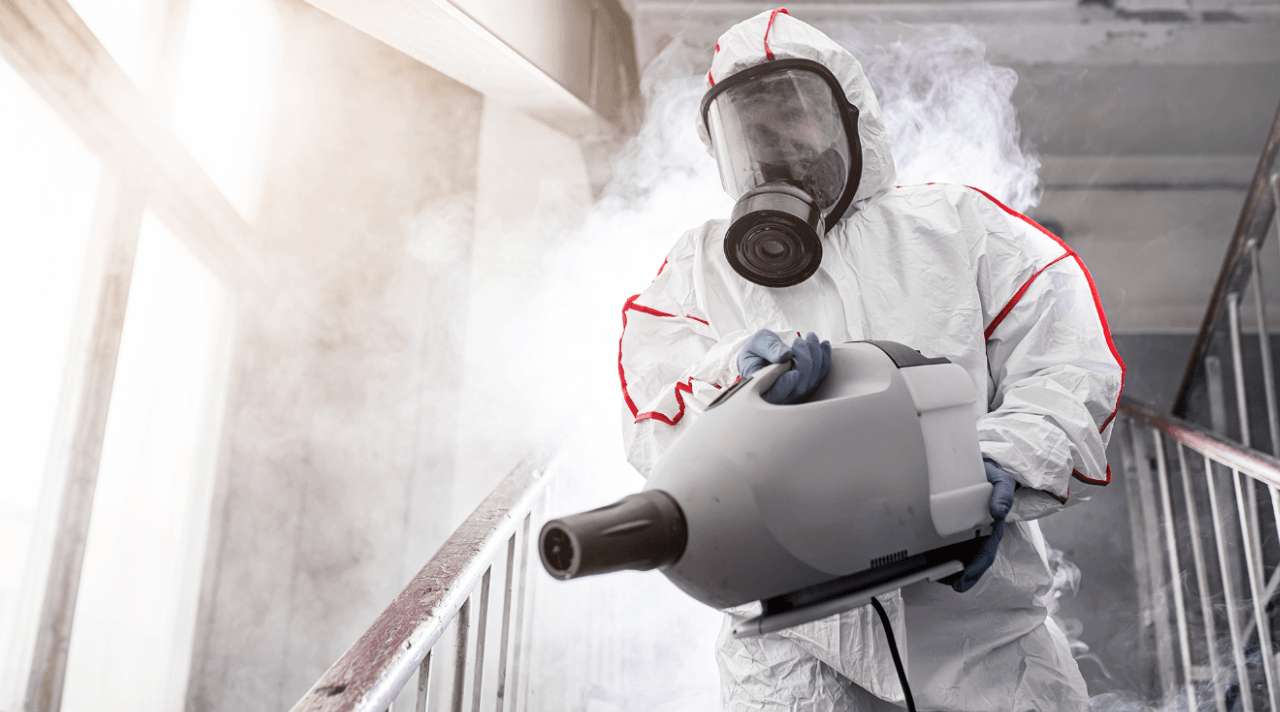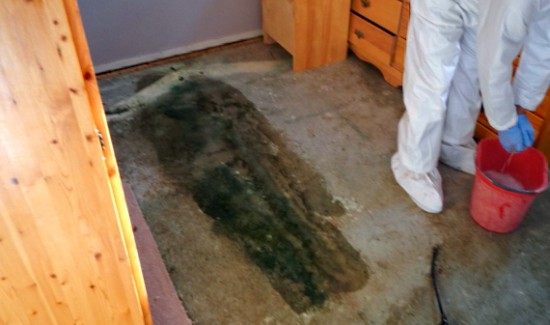Clandestine Lab Cleanup: Comprehensive Decontamination for Hazardous Sites
Clandestine Lab Cleanup: Comprehensive Decontamination for Hazardous Sites
Blog Article
Expert Biohazard Cleansing and Decontamination for Blood, Bodily Fluids, and Hazardous Products
The prospective wellness threats connected with exposure to biohazards emphasize the important demand for meticulous handling and complete clean-up. As we browse the elaborate landscape of biohazard clean-up, comprehending the nuances of guidelines, conformity, and the specialized devices at play comes to be essential in making certain a detailed and risk-free purification process.
Wellness Dangers of Biohazard Direct Exposure
Exposure to biohazards poses significant wellness risks that can cause severe repercussions for areas and people alike. Biohazards include a vast array of biological compounds, consisting of blood, bodily liquids, mold and mildew, germs, viruses, and other possibly contagious materials. When individuals enter into call with these biohazards, whether via crashes, improper handling, or ecological exposure, they encounter the risk of contracting severe illnesses or conditions.
One of the primary health and wellness risks connected with biohazard exposure is the transmission of transmittable diseases. Bloodborne pathogens such as HIV, liver disease B and C, and different germs can be existing in biohazardous products, posturing a direct danger to human health and wellness. Inhaling air-borne biohazards like mold and mildew spores or entering into contact with polluted surface areas can likewise lead to breathing issues, allergic reactions, and other unfavorable health and wellness impacts.
Moreover, biohazard exposure can have lasting health ramifications, with some conditions showing up years after the first call (Blood Cleanup). Therefore, it is important to focus on appropriate biohazard cleaning and decontamination to reduce these wellness dangers and make sure the safety of people and areas

Specialized Educating for Biohazard Cleanup
When it pertains to managing biohazard cleaning efficiently and securely, specialized training plays a basic function in making certain proper purification treatments are adhered to. Biohazard clean-up calls for particular expertise and abilities to efficiently alleviate threats related to bloodborne microorganisms, bodily liquids, and unsafe products. Professionals learnt biohazard clean-up undergo extensive guideline on just how to safely take care of, get rid of, and dispose of biohazardous products to stop contamination and exposure.
Specialized training for biohazard cleanup covers a variety of necessary subjects, consisting of appropriate individual protective equipment (PPE) use, bloodborne microorganism understanding, decontamination methods, and contaminated materials disposal procedures. People educated in biohazard clean-up are equipped with the required proficiency to examine contamination levels, identify possible threats, and carry out appropriate cleanup procedures in compliance with governing criteria.
Constant training and education and learning are vital in the field of biohazard cleaning to stay updated on the most up to date decontamination modern technologies, security protocols, and laws. By buying specialized training, biohazard cleanup specialists can effectively reply to emergency cleaning scenarios and secure both public health and wellness and the setting.
Importance of Proper Purification Techniques
Making use of correct purification strategies is vital in biohazard cleaning to successfully remove harmful materials and lessen health and wellness dangers. Effective check my site purification not just guarantees the removal of noticeable traces of blood, bodily liquids, and other biohazards however likewise targets unseen virus that might present severe health hazards if not properly gotten rid of. By complying with rigid decontamination procedures, trained professionals can substantially lower the risk of exposure to hazardous bacteria, viruses, and germs that could lead to infections or illness.
Proper purification techniques entail the usage of specialized devices and disinfectants that are especially designed to reduce the effects of biohazards effectively. Comprehensive cleansing and sanitation of infected areas are necessary to protect against the spread of microorganisms and make sure a safe environment for residents. Furthermore, the right disposal of biohazardous waste adhering to purification treatments is important in avoiding contamination of other surface areas or people.

Devices and Devices for Safe Clean-up
When dealing with blood, bodily liquids, or dangerous materials, biohazard cleansing professionals count on specialized equipment to lessen direct exposure threats and thoroughly sanitize the afflicted location. Furthermore, biohazard cleaning kits consisting of anti-bacterials, absorbent materials, and biohazard bags are made use of to securely include and get rid of of contaminated things.
Advanced cleaning devices like hospital-grade anti-bacterials, HEPA-filtered vacuum cleaners, and fogging makers are used to disinfect surfaces and eliminate biohazards successfully. Specialized equipment such as sharps containers and biohazard waste disposal containers are used to securely handle sharp objects and biohazardous waste products. By using the appropriate tools and tools, biohazard cleansing professionals can make sure a complete cleanup process that prioritizes safety and security and decreases wellness risks for both workers and passengers of the damaged area.
Laws and Conformity in Biohazard Cleansing
Correct adherence to laws and conformity requirements is extremely important in biohazard cleansing to ensure the safety and security of both personnel and the setting. Government firms such as OSHA (Occupational Safety And Security and Health Management) and the EPA (Epa) have actually developed details guidelines for biohazard cleaning procedures to decrease health and wellness risks and ecological web link contamination. These regulations cover a variety of facets including the handling, transportation, and disposal of biohazardous materials, in addition to the essential training and safety devices required for workers associated with the clean-up procedure.
Biohazard cleaning business have to stay up-to-date with these guidelines to guarantee that their procedures satisfy the required safety requirements. Failure to abide by these regulations can cause severe consequences, including fines, lawsuit, and endangering the health of people and the setting. By adhering to stringent regulations and compliance procedures, biohazard cleaning firms can efficiently alleviate dangers and make sure a risk-free and detailed cleaning process for all parties included.
Verdict
To conclude, biohazard biohazard cleanup osha cleaning and decontamination call for specific training, correct techniques, and adherence to guidelines. Exposure to blood, bodily liquids, and dangerous materials poses substantial wellness dangers, making it critical to use the best devices and devices for safe clean-up. By complying with strict protocols and guidelines, professionals can successfully minimize the risks connected with biohazard exposure and guarantee the safety of both themselves and others.
As we browse the elaborate landscape of biohazard cleanup, recognizing the subtleties of laws, conformity, and the specific equipment at play ends up being vital in making certain a detailed and risk-free purification procedure. (Blood Cleanup)
When it comes to taking care of biohazard cleaning successfully and safely, specialized training plays a fundamental function in guaranteeing proper purification treatments are adhered to.Using appropriate purification strategies is crucial in biohazard cleaning to successfully reduce and eliminate unsafe materials wellness threats. In addition, biohazard cleaning packages including anti-bacterials, absorbing materials, and biohazard bags are made use of to securely dispose and contain of infected products.
Government agencies such as OSHA (Occupational Safety and Wellness Management) and the EPA (Environmental Defense Agency) have actually developed specific guidelines for biohazard cleanup treatments to decrease wellness dangers and ecological contamination.
Report this page